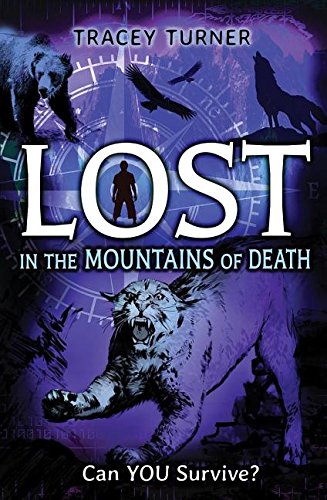| ________________
CM . . .
. Volume XXI Number 32. . . .April 24, 2015
excerpt:
The reader is the protagonist in Lost in the Mountains of Death, separated from friends by an unexpected storm while hiking the Patagonian Andes. Despite the lurid title, this book is grounded in real-life, contemporary survival skills and combines the how-to-survive nonfiction genre with the Choose-Your-Own-Adventure brand of fiction (or, as that phrase is a brand, “Plot-your-own stories,” as the publisher’s information page puts it). The book’s purpose is double: to entertain and to impart extreme survival knowledge. Sprinkled throughout the book at appropriate junctions are one-page fact sheets about conditions in the Andes, wildlife and how to survive specific situations. Sometimes these fact pages appear when the reader-protagonist encounters the creature or condition (the page on Andean condors is placed when the reader comes upon condors feeding); sometimes the fact page appears after the reader has chosen poorly and died (the page on crevasses faces the page on which the reader walks on a glacier and falls into a crevice). The reader will be able to triumph over the situation and survive the Patagonian Andes through logical thinking and basic knowledge of survival skills. The disappointment of having “died” adds spice to the facts provided on why the reader died and how the reader could have avoided dying. This story is a sharp contrast to superhuman-type adventure tales with indestructible protagonists. The final pages after the plot-your-own-story gives information on the peoples who have lived in the Andes, native animals other than those encountered in the tale, real-life Andes survival stories, and a page on the Inca Empire. This is followed by useful resources: a glossary (all terms in the glossary were also defined when they appeared in the story); a list of suggested books for further reading; a list of child-friendly websites on how to survive in the wilderness; and an index. The only flaw with these resources is that the list of books for further reading does not distinguish between survival fiction (Lost in the Barrens) and nonfiction (The Worst Case Scenario Survival Handbook). Almost every page of text is enlivened by a black and white illustration. The illustrations vary in style and include sketches, paintings, photographs, and various graphics. Despite these varied mediums, the illustrations appear unified, with the exception of the bold skull and crossbones which accompanies every page in which the reader’s adventure ends in death. The illustrations give a sense of place and wonder and add visual interest to the text, although this effect is slightly diminished by the reuse of several images. In the most blatant case, the same mountain painting is used ten times. The language is simple, with uncommon or technical terms such as crampon defined as they appear. Sentences are likewise simple and convey a sense of immediacy which fits the second-person narration and the story’s set-up as an adventure experienced by the reader. The choices were clearly written, and the page numbers easy to find. Lost in the Mountains of Death is an enjoyable way to pick up facts on survival in cold-weather conditions. Recommended. Janet Eastwood recently graduated with a Master of Arts in Children’s Literature from the University of British Columbia.
To comment
on this title or this review, send mail to cm@umanitoba.ca.
Copyright © the Manitoba Library Association. Reproduction for personal
use is permitted only if this copyright notice is maintained. Any
other reproduction is prohibited without permission.
Next Review |
Table of Contents for This Issue
- April 24, 2015. |
